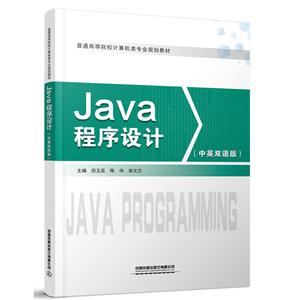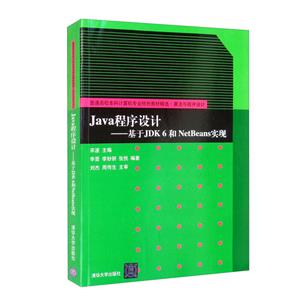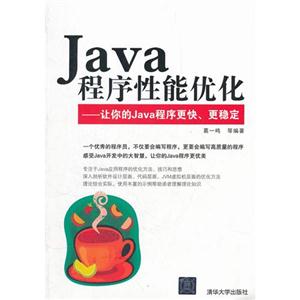
作者:何月顺
页数:339
出版社:电子工业出版社
出版日期:2020
ISBN:9787121169823
电子书格式:pdf/epub/txt
内容简介
Java是一种良好的跨平台、可移植性好、安全性高、纯面向对象的程序设计语言,是目前软件开发的主流编程语言之一。本书由浅入深、循序渐进地介绍了Java语言的发展、编程环境、开发工具、基本语法、面向对象编程、异常处理、线程、输入输出流、GUI编程、网络编程、数据库编程等内容,并结合大量的实例进行讲解。
本书是国内首次出版的中英文对照混排式双语版Java程序设计教材。本书内容注重理论与实践结合,参考了Java在线官方文档及国内外优秀的Java程序设计教材的知识体系。针对中国学生英文水平及实际教学状况,做了针对性的编写,并对重要的、难以理解的内容进行了中文解释,方便了读者对英文的理解。
通过本书的学习,可使学生了解Java语言的发展,理解Java面向对象编程的基本思想,掌握Java语言的基本语法、面向对象程序设计的实现思想、多线程编程、网络程序开发及数据库访问等方面的基本技术。
本书特色
《国外计算机科学教材系列:Java程序设计(双语版)》贯彻理论与实践相结合的原则,深入浅出,配以大量实例分析,同时作为中英文对照教材,非常适合高校进行“Java程序设计”课程的双语教学。《国外计算机科学教材系列:Java程序设计(双语版)》既可作为高等学校Java程序设计或专业英语课程的教材,也可供从事Java程序开发的从业人员学习、参考。
目录
Chapter 1 Genesis of Java 1
Java概述
1.1 Introduction 1
Java简介
1.2 Java Development Today 1
Java发展历史
1.3 Evolution of ‘C’ Based Programming Languages 1
C系列语言发展
1.4 Main Features of Java Programming Language 2
Java语言的主要特性
1.4.1 Portability 2
轻量级
1.4.2 Simple 3
简单
1.4.3 Robust 3
健壮
1.4.4 Multithread 4
多线程
1.4.5 Architecture-Neutral 4
平台无关
1.4.6 Interpreted and High Performance 5
解释性和高效
1.4.7 Distributed 5
分布式
1.4.8 Dynamic 5
动态
1.4.9 Security 5
安全
1.5 Java Applet 6
Java Applet小应用程序
1.6 Exercise for you 7
课后习题
Chapter 2 Java Overview 8
Java总览
2.1 Concepts of OOP 8
面向对象程序设计
2.1.1 Class 9
类
2.1.2 Object 9
对象
2.1.3 Encapsulation 10
封装
2.1.4 Inheritance 10
继承
2.1.5 Polymorphism 11
多态
2.2 More Details on Object-Oriented Programming 11
面向对象程序设计具体实例
2.2.1 Encapsulation of Car 12
Car类封装
2.2.2 Inheritance of Car 12
Car类继承
2.2.3 Polymorphism of Car 13
Car类多态
2.2.4 Conclusion on Object-Oriented Programming 13
面向对象程序设计小结
2.3 Write the First Java Program 14
编写第一个Java程序
2.4 How to Run the First Java Program 15
运行第一个Java程序
2.5 Lexical Elements 16
语法规则
2.6 White Space 17
空白符
2.7 Comments 18
注解
2.7.1 Single Line 18
单行注解
2.7.2 Multi-line 18
多行注解
2.7.3 Javadoc 18
Javadoc注解
2.8 Keywords 19
关键字
2.9 Identifiers 19
标志符
2.10 Java Class Library 20
Java类库
2.11 Sample Program Practice 20
程序实例
2.12 Exercise for you 21
课后习题
Chapter 3 Data Types 22
数据类型
3.1 Data Types Overview 22
数据类型概述
3.2 Primitive Types 23
基本数据类型
3.3 Casting 23
类型转换
3.3.1 Widening 24
类型扩展
3.3.2 Narrowing 24
类型收缩
3.4 Reference Types 24
引用类型
3.5 Summary 25
基本类型汇总
3.6 Complex Data Types 26
复合数据类型
3.6.1 Reference Data Types 26
引用数据类型
3.6.2 Class Types 26
类类型
3.6.3 Interface Types 26
接口类型
3.7 Composite Data Types 27
构造复合数据类型
3.7.1 Initializing Composite Data Types 27
复合数据类型数据初始化
3.7.2 Predefined Composite Data Types 28
预定义复合数据类型
3.8 Casting Variables to a Different Type 28
不同数据类型转换
3.8.1 Automatic Casting 28
自动转换
3.8.2 Explicit Casting 28
显式转换
3.9 Java’s Floating Point Types 29
浮点数据
3.9.1 Primitive Floating Point Types 29
基本浮点类型
3.9.2 Integer Operators 29
整型运算符
3.9.3 Input and Output of Floating Point Values 30
输入输出浮点数据
3.9.4 Casting of Floating Point to and from Integer Values, and Floating Point Literals 30
整型数据和浮点型字符转换为浮点数据
3.9.5 Floating Point Operations in the Standard Packages 30
系统包中的浮点运算
3.9.6 The Float Class 31
Float类
3.10 Variable 32
变量
3.10.1 Declaring a Variable 32
变量声明
3.10.2 Difference between Zero and ‘0’-Unicode Characters 33
区分数字0和字符0
3.10.3 Initialization of the Variable 33
变量初始化
3.10.4 Error Checking by the Compiler 33
编译错误
3.10.5 Using the Cast Operator 33
类型转换符的使用
3.10.6 Why Declare the Variables as Type Int? 33
变量声明为整型
3.10.7 Shortcut Declaring Variables of the Same Type 33
同类型变量的声明
3.10.8 Assigning Values to Variables 34
变量赋值
3.10.9 A Shortcut, Declare and Assign at the Same Time 34
变量同时声明与赋值
3.11 Record 34
记录
3.12 Sample Program Practice 35
程序实例
3.13 Exercise for you 36
课后习题
Chapter 4 Operators 37
运算符
4.1 Arithmetic Operators 37
算术运算符
4.1.1 The Modulus Operators 37
取模运算符
4.1.2 Arithmetic Assignment Operators 38
算术赋值运算符
4.1.3 Increment and Decrement 38
自增与自减运算符
4.2 Relational Operators 39
关系运算符
4.3 Boolean Logical Operators 39
逻辑运算符
4.4 Bitwise and Shift Operators 41
位运算符与移位运算符
4.4.1 Bitwise Complement (~) 41
按位取反运算符
4.4.2 Bitwise AND (&) 41
按位与运算符
4.4.3 Bitwise OR ( | ) 41
按位或运算符
4.4.4 Bitwise XOR (^) 42
按位异或运算符
4.4.5 Left Shift (<<) 42
按位左移运算符
4.4.6 Signed Right Shift (>>) 42
带符号按位右移运算符
4.4.7 Unsigned Right Shift (>>>) 43
无符号按位右移运算符
4.5 Assignment Operators 43
赋值运算符
4.6 The Conditional Operator 44
条件运算符
4.7 The Instanceof Operator 44
instanceof运算符
4.8 Special Operators 45
特殊运算符
4.8.1 Object Member Access (.) 45
对象成员访问符(.)
4.8.2 Array Element Access ([ ]) 45
数组元素访问符([ ])
4.8.3 Method Invocation (( )) 46
方法调用操作符
4.8.4 Object Creation (new) 46
对象创建运算符
4.9 Type Conversion or Casting 46
数据类型转换
4.10 Sample Program Practice 46
程序实例
4.11 Exercise for you 49
课后习题
Chapter 5 Flowing Control 50
控制流
5.1 Control Statements 50
控制表达式
5.2 Selection Statements 50
分支表达式
5.2.1 If Statement 50
if表达式
5.2.2 If-else Statement 51
if-else表达式
5.2.3 Switch Statement 51
switch表达式
5.3 Repetition Statements 52
循环表达式
5.3.1 While Loop Statement 52
while循环表达式
5.3.2 Do-while Loop Statement 53
do-while循环表达式
5.3.3 For Loop Statement 54
for循环表达式
5.4 Branching Statements 54
分支跳转表达式
5.4.1 Break Statement 54
break表达式
5.4.2 Continue Statement 55
continue表达式
5.4.3 Return Statement 55
return表达式
5.5 Sample Program Practice 56
程序实例
5.6 Exercise for you 58
课后习题
Chapter 6 Class 59
类
6.1 Class Definition 59
类定义
6.1.1 A Simple Class Definition 60
简单类定义示例
6.1.2 Defining a Class 60
定义类
6.2 Declaring and Instantiating an Object 62
对象定义与初始化
6.2.1 Fields and Methods 65
成员和方法
6.2.2 Default Values for Primitive Members 66
基本类型数据成员的缺省值
6.2.3 Methods, Arguments, and Return Values 66
方法、参数和返回值
6.2.4 The Argument List 67
参数列表
6.3 Constructor 68
构造方法
6.3.1 Calling Constructors from Constructors 70
构造方法中调用构造方法
6.3.2 Default Constructors 71
缺省构造方法
6.4 Keyword “this” 72
this关键字
6.5 Garbage Collection 74
垃圾回收
6.5.1 The Use of finalize( ) 75
finalize方法的使用
6.5.2 Cleanup 76
垃圾清理
6.6 Static Methods and Static Variables 79
静态方法和静态变量
6.6.1 Static Methods 79
静态方法
6.6.2 Static Variables 80
静态变量
6.7 Sample Examples 82
程序实例
6.8 Exercise for you 84
课后习题
Chapter 7 Method 85
方法
7.1 Method Overloading 85
方法重载
7.1.1 Distinguishing Overloaded Methods 87
方法重载匹配
7.1.2 Overloading with Primitives 87
基本数据类型参数重载
7.1.3 Overloading on Return Values 91
基于返回值重载
7.1.4 Overriding with Constructors 92
构造方法重载
7.2 Parameter Passing in Java-By Reference or By Value 93
Java参数传递:引用传递和值传递
7.2.1 Passing Named Arguments to Java Programs 94
给Java程序传递参数
7.2.2 Passing Information into a Method 95
方法信息传递
7.2.3 Pass by Value 97
值传递
7.2.4 Passing Primitive Types 100
传递基本类型参数
7.2.5 Return Values 101
返回值
7.2.6 Passing Object References 101
传递对象引用
7.2.7 Passing Strings 102
传递字符串
7.2.8 Passing Arrays 103
传递数组
7.3 Recursion 103
递归
7.4 Controlling Access to Members of a Class 105
类成员访问控制
7.4.1 Class Access Level 106
类级别访问
7.4.2 Package Access Level 107
包级别访问
7.5 Static Import 108
静态导入
7.6 Arrays 109
数组
7.6.1 Array Overview 109
数组概述
7.6.2 Java Arrays 114
Java数组
7.7 String 116
字符串
7.7.1 Creating a String 116
字符串创建
7.7.2 Strings Operation 117
字符串操作
7.7.3 Alter Strings 117
字符串修改
7.8 Command Line Arguments 117
命令行参数
7.9 Sample Examples 118
程序实例
7.10 Exercise for you 122
课后习题
Chapter 8 Inheritance 123
继承
8.1 Derived Classes 123
派生类
8.2 Abstract Classes 128
抽象类
8.3 Keyword “final” 130
final关键字
8.3.1 Final Data 130
final数据
8.3.2 Final Methods 133
final方法
8.3.3 Final Classes 135
final类
8.4 Sample Example 136
程序实例
8.5 Exercise for you 140
课后习题
Chapter 9 Packages and Interfaces 141
包和接口
9.1 Package 141
包
9.1.1 Packages Overview 141
包概述
9.1.2 Packages in Java 142
Java包
9.1.3 Access Specifiers 142
访问标志符
9.1.4 How to Create a Package 144
包的创建
9.1.5 Setting Up the CLASSPATH 145
类路径设置
9.1.6 Subpackage (Package inside Another Package) 146
子包(一个包在另一个包中)
9.1.7 How to Use Package 147
使用包
9.2 Interface 149
接口
9.2.1 Interface Overview 149
接口概述
9.2.2 Creating and Using Interfaces 150
创建和使用接口
9.2.3 Defining an Interface 151
接口的定义
9.2.4 The Interface Body 151
接口体
9.2.5 Implementing an Interface 152
接口的实现
9.2.6 Using an Interface as a Type 153
接口类型
9.3 Sample Example 153
程序实例
9.4 Exercise for you 156
课后习题
Chapter 10 Exception Handling 157
异常处理
10.1 Definition of Exception 157
异常定义
10.1.1 What is an Exception 157
什么是异常
10.1.2 Common Exceptions 157
普通异常
10.1.3 The Throwable Superclass 158
Throwable类
10.1.4 Effectively Using try-catch 159
有效使用try-catch
10.1.5 When should You Use Exceptions 162
何时使用异常
10.1.6 How do You Best Use Exceptions 163
如何最大限度的使用异常处理
10.2 The Throw Statement 166
throw表达式
10.3 The Finally Statement 166
finally表达式
10.4 Runtime Exceptions 167
运行时异常
10.4.1 ArithmeticException 167
ArithmeticException类
10.4.2 PointerException 167
PointerException类
10.4.3 IncompatibleClassChangeException 168
IncompatibleClassChangeException类
10.4.4 ClassCastException 168
ClassCastException类
10.4.5 NegativeArraySizeException 168
NegativeArraySizeException类
10.4.6 OutOfMemoryException 169
OutOfMemoryException类
10.4.7 NoClassDefFoundException 169
NoClassDefFoundException类
10.4.8 IncompatibleTypeException 169
IncompatibleTypeException类
10.4.9 ArrayIndexOutOfBoundsException 170
ArrayIndexOutOfBoundsException类
10.4.10 UnsatisfiedLinkException 170
UnsatisfiedLinkException类
10.5 Sample Examples 170
程序实例
10.6 Exercise for you 174
课后习题
Chapter 11 Multithread 175
多线程
11.1 Multithread Overview 175
多线程概述
11.2 Synchronization 179
同步
11.2.1 Inter-thread Communication 181
线程间通信
11.2.2 Java Thread Scheduling 183
Java线程调度
11.2.3 Thread Priorities 184
线程优先级
11.2.4 Java Synchronization 185
Java线程同步
11.3 The Life Cycle of a Thread 187
线程生命周期
11.3.1 Creating a Thread 187
线程创建
11.3.2 Starting a Thread 188
线程启动
11.3.3 Making a Thread Not Runnable 189
使线程处于非运行状态
11.3.4 Stopping a Thread 190
线程停止
11.3.5 Testing Thread State 191
线程状态测试
11.3.6 Why Pause and Resume Processes 193
线程暂停和继续
11.4 Sample Examples 194
程序实例
11.5 Exercise for you 198
课后习题
Chapter 12 Input and Output 199
输入与输出
12.1 Basic Java I/O 199
Java I/O基础
12.1.1 Background 200
背景
12.1.2 Exceptions 200
异常
12.1.3 Applications 200
应用
12.1.4 File Attributes 200
文件属性
12.2 Streams 201
流
12.2.1 Byte Streams 202
字节流
12.2.2 Character Streams 203
字符流
12.2.3 Buffered Streams 206
缓冲流
12.2.4 Data Streams 207
数据流
12.2.5 Class StreamTokenizer 208
StreamTokenizer类
12.2.6 Class StringTokenizer 209
StringTokenizer类
12.3 Class File 210
File类
12.3.1 The PrintWriter Class 211
PrintWriter类
12.3.2 Constructor Method 211
构造方法
12.3.3 File Handling and Input/Output 212
文件处理与输入输出
12.3.4 The Basic Input Output 218
基本输入输出流类
12.4 Sample Examples 225
程序实例
12.5 Exercise for you 227
课后习题
Chapter 13 String Handling 228
字符串处理
13.1 The String Class 228
String类
13.2 Strings in Java 229
Java字符串
13.2.1 String Basics 229
字符串基础
13.2.2 Creating a String 230
字符串创建
13.2.3 Comparing Strings 232
字符串比较
13.2.4 Other Operations 233
字符串其他操作
13.2.5 StringBuffer Objects 238
StringBuffer类
13.2.6 String Analyzing 240
字符串分析
13.3 Sample Examples 241
程序实例
13.4 Exercise for you 243
课后习题
Chapter 14 Networking 244
网络
14.1 Computer Network Basics 244
计算机网络基础
14.2 URL Objects in Java 247
Java URL对象
14.2.1 Creating URL Objects 247
创建URL对象
14.2.2 Query Methods on URL Objects 247
URL对象查询方法
14.2.3 Reading from a URL Connection 248
从URL连接读取数据
14.2.4 URL Operations 249
URL操作
14.3 Sockets in Java 259
Java套接字
14.3.1 Establishing a Connection 259
建立连接
14.3.2 The Client Side of a Socket Connection 259
套接字连接的客户端
14.3.3 Socket Operations 262
套接字操作
14.4 Sample Examples 268
程序实例
14.5 Exercise for you 272
课后习题
Chapter 15 Applets 273
Applet小应用程序
15.1 Applet Overview 273
Applet概述
15.2 Life Cycle, Graphics, Fonts, Colors 274
Applet生命周期、图形、字体、颜色
15.2.1 Life Cycle of an Applet 274
Applet生命周期
15.2.2 Parameter Passing 276
参数传递
15.2.3 Graphics Class 276
Graphics类
15.2.4 Font Class 276
Font类
15.2.5 Color Class 277
Color类
15.3 User Interface Components 277
使用组件接口
15.4 Applet Fundamentals 278
Applet基础
15.4.1 The Applet Class 278
Applet类
15.4.2 Applet Architecture 279
Applet体系结构
15.4.3 Requesting Repainting 280
请求重画
15.5 Working with URLs and Graphics 283
URL与图形的应用
15.6 Using the instanceof Keyword in Java 284
Java中instanceof关键字应用
15.7 Sample Examples 285
程序实例
15.8 Exercise for you 288
课后习题
Chapter 16 Swing GUI Introduction 289
图形用户界面Swing
16.1 Event-Driven Programming 289
基于事件驱动编程
16.2 Event Handling 291
事件处理
16.2.1 The Component Class 291
Component类
16.2.2 The Event Class 292
Event类
16.2.3 Event Handling for the Mouse 293
鼠标事件处理
16.2.4 Keyboard Event Handling 294
键盘事件处理
16.3 Buttons, Events, and Other Swing Basics 295
按钮、事件和其他Swing基础
16.3.1 Buttons 298
按钮
16.3.2 Action Listeners and Action Events 298
动作监听器和动作事件
16.3.3 Labels 300
标签
16.3.4 Color 301
颜色
16.4 Containers and Layout Managers 303
容器和布局管理器
16.4.1 Border Layout Managers 304
边界布局管理器
16.4.2 Flow Layout Managers 307
流式布局管理器
16.4.3 Grid Layout Managers 307
格点布局管理器
16.4.4 Panels 309
面板
16.4.5 The Container Class 313
Container类
16.5 Menus and Buttons 314
菜单和按钮
16.5.1 Menu Bars, Menus, and Menu Items 314
菜单条、菜单和菜单项
16.5.2 The AbstractButton Class 317
AbstractButton类
16.5.3 The setActionCommand Method 318
setActionCommand方法
16.5.4 Listeners as Inner Classes 319
内部类监听器
16.6 Text Fields and Text Areas 320
文本域和文本区
16.6.1 Text Areas and Text Fields 321
文本域和文本区
16.6.2 Window Listeners 322
窗口监听器
16.7 Sample Examples 323
程序实例
16.8 Exercise for you 325
课后习题
Chapter 17 Programming with JDBC 326
JDBC编程
17.1 JDBC Introduction 326
JDBC介绍
17.2 Connecting to the Database 327
数据库连接
17.2.1 A Simple Database Connection 328
简单的数据库连接示例
17.2.2 The JDBC Classes for Creating a Connection 329
创建连接的JDBC类
17.3 Basic Database Access 330
数据库访问基础
17.3.1 Basic JDBC Database Access Classes 330
访问数据库的JDBC基础类
17.3.2 SQL versus Java 332
SQL空值与Java空值
17.3.3 Clean Up 332
清理
17.3.4 Modifying the Database 332
修改数据库
17.4 SQL Data Types and Java Data Types 333
SQL数据类型和Java数据类型
17.5 Scrollable Result Sets 335
滚动结果集
17.5.1 Result Set Types 335
结果集类型
17.5.2 Result Set Navigation 335
结果集导引
17.6 Sample Examples 336
程序实例
17.7 Exercise for you 339
课后习题













